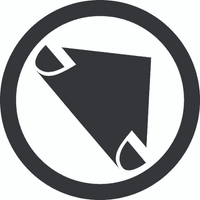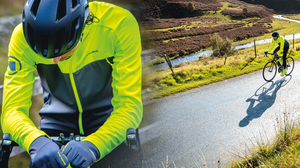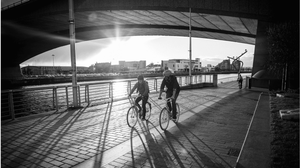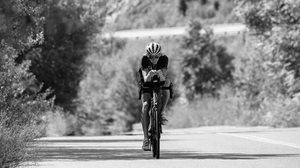
Helmets are a key bit of safety equipment and critical part of every riders PPE. However, they can only provide protection when they’re worn properly and fitted correctly.
We’ll start with the obvious - a helmet hanging off your handlebars or strapped to a backpack when you’re riding might as well be sitting on the kitchen table, so whenever you’re on your bike it needs to be on your head with the strap done up.
Start by putting the helmet on, with the strap undone. Adjust the helmet so that the front sits evenly a finger width or two above your eyebrows - too far back and it won't protect the front of your head and two far forwards and it might interfere with your vision.
Our helmets use a retention device to ensure a perfect fit. Use the dial on the back of the helmet to create a snug fit - you should be able to put your head down now and give it a shake about without the helmet falling off.
Clip the chin strap together and adjust this so that it's tight, but not too tight, under your chin. Too loose and it could move about if you have a crash, but make sure you can get a finger or two through.
Next adjust the V that the straps form with your ears inside the V and adjuster just below. This can be a bit fiddly, but it’s a one time job (unless your ears move about).
MTB helmets come with a visor, to helps to keep sun and rain out of your eyes, and depending on the model, these can be adjusted for angle (MT500, SingleTrack) or removed tool free (Hummvee, Hummvee Youth).
Helmet safety
If you’re using your old helmet or borrowing one, give it a good pull and push from front to back and side to side – helmets work by absorbing the forces that would otherwise be passed through to your skull and are designed to deform and break up in a crash. Even a small amount of damage will compromise it’s effectiveness and it’ll need to be replaced. Also check that the straps aren’t cut or frayed, any damage here and it’s time to replace it too.
Helmets shouldn't be used by children while climbing or doing other activities as there’s a risk of strangulation/hanging if the child gets trapped with the helmet.
The materials used in helmets degrade over time and we recommend that you replace your Endura helmet every five years, but if it’ been damaged in a crash or otherwise then it needs to be discarded and destroyed, just in case someone else gets hold of it (cutting the straps off is a good way to do this).
Only clean your helmet with a mild cleaning agent and warm water. The internal foam pads should be hand washed and left to drip dry.
We recommend that you store your helmet in a cool dry place. Temperatures above 50C can affect the protective ability of the helmet and it’s quite easy for gear left in a car on a hot and sunny day to exceed that level.
Endura Crash Replacement Scheme
If you’re unfortunate enough to be involved in an accident that has caused any impact to the helmet then we offer a crash replacement service to reduce the cost of replacing your helmet to 50% MRP at the time of replacement.

Related Articles








